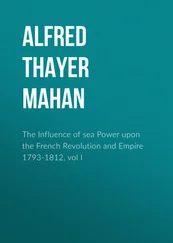Alfred Thayer Mahan - Sea Power in its Relations to the War of 1812. Volume 1
Здесь есть возможность читать онлайн «Alfred Thayer Mahan - Sea Power in its Relations to the War of 1812. Volume 1» — ознакомительный отрывок электронной книги совершенно бесплатно, а после прочтения отрывка купить полную версию. В некоторых случаях можно слушать аудио, скачать через торрент в формате fb2 и присутствует краткое содержание. Жанр: foreign_prose, История, foreign_edu, foreign_antique, на английском языке. Описание произведения, (предисловие) а так же отзывы посетителей доступны на портале библиотеки ЛибКат.
- Название:Sea Power in its Relations to the War of 1812. Volume 1
- Автор:
- Жанр:
- Год:неизвестен
- ISBN:нет данных
- Рейтинг книги:4 / 5. Голосов: 1
-
Избранное:Добавить в избранное
- Отзывы:
-
Ваша оценка:
- 80
- 1
- 2
- 3
- 4
- 5
Sea Power in its Relations to the War of 1812. Volume 1: краткое содержание, описание и аннотация
Предлагаем к чтению аннотацию, описание, краткое содержание или предисловие (зависит от того, что написал сам автор книги «Sea Power in its Relations to the War of 1812. Volume 1»). Если вы не нашли необходимую информацию о книге — напишите в комментариях, мы постараемся отыскать её.
Sea Power in its Relations to the War of 1812. Volume 1 — читать онлайн ознакомительный отрывок
Ниже представлен текст книги, разбитый по страницам. Система сохранения места последней прочитанной страницы, позволяет с удобством читать онлайн бесплатно книгу «Sea Power in its Relations to the War of 1812. Volume 1», без необходимости каждый раз заново искать на чём Вы остановились. Поставьте закладку, и сможете в любой момент перейти на страницу, на которой закончили чтение.
Интервал:
Закладка:
The British American colonies were divided by geographical conditions into two primary groups: those of the West India Islands, and those of the Continent. The common use of the latter term, in the thought and speech of the day, is indicated by the comprehensive adjective "Continental," familiarly applied to the Congress, troops, currency, and other attributes of sovereignty, assumed by the revolted colonies after their declaration of independence. Each group had special commercial characteristics—in itself, and relatively to Great Britain. The islands, whatever their minor differences of detail, or their mutual jealousies, or even their remoteness from one another,—Jamaica being a thousand miles from her eastern sisters,—were essentially a homogeneous body. Similarity of latitude and climate induced similarity of social and economical conditions; notably in the dependence on slave labor, upon which the industrial fabric rested. Their products, among which sugar and coffee were the most important, were such as Europe did not yield; it was therefore to their advantage to expend labor upon these wholly, and to depend upon external sources for supplies of all kinds, including food. Their exports, being directed by the Navigation Act almost entirely upon Great Britain, were, in connection with Virginia tobacco, the most lucrative of the "enumerated" articles which rendered tribute to the entrepôt monopoly of the mother country. It was in this respect particularly, as furnishing imports to be handled and re-exported, that the islands were valuable to the home merchants. To the welfare of the body politic they contributed by their support of the carrying trade; for the cargoes, being bulky, required much tonnage, and the entire traffic was confined to British ships, manned three-fourths by British seamen. As a market also the islands were of consequence; all their supplies coming, by law, either from or through Great Britain, or from the continental colonies. Intercourse with foreign states was prohibited, and that with foreign colonies allowed only under rare and disabling conditions. But although the West Indies thus maintained a large part of the mother country's export trade, the smallness of their population, and the simple necessities of the slaves, who formed the great majority of the inhabitants, rendered them as British customers much inferior to the continental colonies; and this disparity was continually increasing, for the continent was growing rapidly in numbers, wealth, and requirements. In the five years 1744-48, the exports from Great Britain to the two quarters were nearly equal; but a decade later the continent took double the amount that the islands demanded. The figures quoted for the period 1754-58 are: to the West Indies, £3,765,000; to North America, £7,410,000. 41 41 Macpherson, vol. iii. p. 317.
In the five years ending 1774 the West Indies received £6,748,095; the thirteen continental colonies, £13,660,180. 42 42 Report of Committee of Privy Council, Jan. 28, 1791, pp. 21-23.
Imports from the continent also supported the carrying trade of Great Britain, but not to an extent proportionate to those from the islands; for many of the continental colonies were themselves large carriers. The imports to them, being manufactured articles, less bulky than the exports of the islands, also required less tonnage. The most marked single difference between the West India communities and those of the continent was that the latter, being distributed on a nearly north and south line, with consequent great divergences of climate and products, were essentially not homogeneous. What one had, another had not. Such differences involve of course divergence of interests, with consequent contentions and jealousies, the influence of which was felt most painfully prior to the better Union of 1789, and never can wholly cease to act; but, on the other hand, it tends also to promote exchange of offices, where need and facility of transport combine to make such exchange beneficial to both. That the intercourse between the continental colonies required a tonnage equal to that employed between them and the West Indies,—testified by the return of 1770 before quoted, 43 43 Ante, p. 31 (note).
—shows the existence of conditions destined inevitably to draw them together. The recognition of such mutual dependence, when once attained, furthers the practice of mutual concession for the purpose of combined action. Consequently, in the protracted struggle between the centripetal and centrifugal forces in North America, the former prevailed, though not till after long and painful wavering.
While thus differing greatly among themselves in the nature of their productions, and in their consequent wants, the continental colonists as a whole had one common characteristic. Recent occupants of a new, unimproved, and generally fertile country, they turned necessarily to the cultivation of the soil as the most remunerative form of activity, while for manufactured articles they depended mainly upon external supplies, the furnishing of which Great Britain reserved to herself. For these reasons they afforded the great market which they were to her, and which by dint of habit and of interest they long continued to be. But, while thus generally agricultural by force of circumstances, the particular outward destinations of their surplus products varied. Those of the southern colonies, from Maryland to Georgia, were classed as "enumerated," and, with the exception of the rice of South Carolina and Georgia, partially indulged as before mentioned, must be directed upon Great Britain. Tobacco, cotton, indigo, pitch, tar, turpentine, and spars of all kinds for ships, were specifically named, and constituted much the larger part of the exports of those colonies. These were carried also chiefly by British vessels, and not by colonial. The case was otherwise in the middle colonies, Pennsylvania, New York, New Jersey, and in Connecticut and Rhode Island of the eastern group. They were exporters of provisions,—of grain, flour, and meat, the latter both as live stock and salted; of horses also. As the policy of the day protected the British farmer, these articles were not required to be sent to Great Britain; on the contrary, grain was not allowed admission except in times of scarcity, determined by the price of wheat in the London market. The West Indies, therefore, were the market of the middle colonies; the shortness of the voyage, and the comparatively good weather, after a little southing had been gained, giving a decisive advantage over European dealers in the transportation of live animals. Flour also, because it kept badly in the tropics, required constant carriage of new supplies from sources near at hand. Along with provisions the continental vessels took materials for building and cooperage, both essential to the industry of the islands,—to the housing of the inhabitants, and to the transport of their sugar, rum, and molasses. In short, so great was the dependence of the islands upon this trade, that a well-informed planter of the time quotes with approval the remark of "a very competent judge," that, "if the continent had been wholly in foreign hands, and England wholly precluded from intercourse with it, it is very doubtful whether we should now have possessed a single acre in the West Indies." 44 44 Bryan Edwards, West Indies, vol. ii. p. 486.
Now this traffic, while open to all British shipping, was very largely in the hands of the colonists, who built ships decidedly cheaper than could be done in England, and could distribute their tonnage in vessels too small to brave the Atlantic safely, but, from their numbers and size, fitted to scatter to the numerous small ports of distribution, which the badness of internal communications rendered advantageous for purposes of supply. A committee of the Privy Council of Great Britain, constituted soon after the independence of the United States to investigate the conditions of West India trade, reported that immediately before the revolt the carriage between the islands and the continent had occupied 1610 voyages, in vessels aggregating 115,634 tons, navigated by 9718 men. These transported what was then considered "the vast" American cargo, of £500,000 outward and £400,000 inward. But the ominous feature from the point of view of the Navigation Act was that this was carried almost wholly in American bottoms. 45 45 Chalmers, Opinions, p. 133.
In short, not to speak of an extensive practice of smuggling, facilitated by a coast line too long and indented to be effectually watched,—mention of which abounds in contemporary annals, 46 46 See, for instance, the Colden Papers, Proceedings N.Y. Historical Society, 1877. There is in these much curious economical information of other kinds.
—a very valuable part of the British carrying trade was in the hands of the middle colonists, whose activity, however, did not stop even there; for, not only did they deal with foreign West Indies, 47 47 A comparison of the figures just quoted, as to the British West Indies, with Sheffield's Table VII., indicates that the trade of the Continent with the foreign islands about equalled that with the British. The trade with the French West Indies, "open or clandestine, was considerable, and wholly in American vessels."—Macpherson, vol. iii. p. 584.
but the cheapness of their vessels, owing to the abundance of the materials, permitted them to be used also to advantage in a direct trade with southern Europe, their native products being for the most part "not enumerated." As early as 1731, Pennsylvania employed eight thousand tons of shipping, while the New England colonies at the same time owned forty thousand tons, distributed in six hundred vessels, manned by six thousand seamen.
Интервал:
Закладка:
Похожие книги на «Sea Power in its Relations to the War of 1812. Volume 1»
Представляем Вашему вниманию похожие книги на «Sea Power in its Relations to the War of 1812. Volume 1» списком для выбора. Мы отобрали схожую по названию и смыслу литературу в надежде предоставить читателям больше вариантов отыскать новые, интересные, ещё непрочитанные произведения.
Обсуждение, отзывы о книге «Sea Power in its Relations to the War of 1812. Volume 1» и просто собственные мнения читателей. Оставьте ваши комментарии, напишите, что Вы думаете о произведении, его смысле или главных героях. Укажите что конкретно понравилось, а что нет, и почему Вы так считаете.












